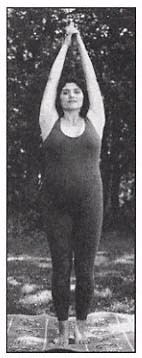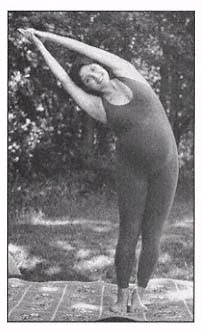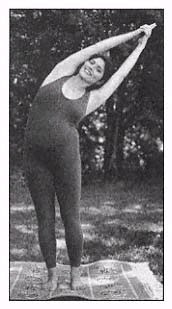Choosing Waterbirth: Reclaiming the Sacred Power of Birth (10 page)
Read Choosing Waterbirth: Reclaiming the Sacred Power of Birth Online
Authors: Lakshmi Bertram,Sandra Amrita McLanahan,Michel Odent

Page 60
shoulders up and back and down and then stretch up, lifting the center of your head toward the ceiling. Now, stand there a moment to see how this feels. It may feel a little unnatural at first, but the more you practice becoming aware of how you are standing, the easier it will be to remember to maintain good posture.
Hip Rocks, Forward and Back
: Stand with your feet a comfortable distance apart, slightly wider than the width of your shoulders. Bend your knees slightly; place your hands on your hips. Slowly tip your pelvis forward in a tuck, tighten your lower abdominal muscles and squeeze your buttocks to tuck your pelvis up. Squeeze tight. Then, slowly release and rock back the other way. Sticking your buttocks way back, feel the muscles in your lower back tighten and feel the muscles across the front of your belly stretch and relax. Tipping forward again, feel the relaxation in your lower back as your front tightens again. Repeat this process, front and back, eight to ten times, as is comfortable for you.
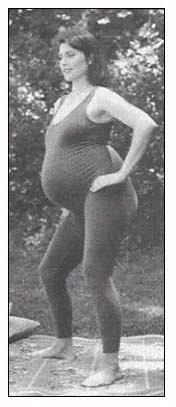
Page 61
Hip Circles
: From the same standing position as you held for the hip rocks, tip your hips to the right, then roll around to the back, roll to the left, and then to the front.
Continue rolling, focusing on doing the complete motion for each circle, as if you were doing a hulahoop. Don't be afraid to move. Do eight to ten repetitions to the right and to the left.
BENEFITS: Hip circles and hip rocks are invaluable in pregnancy. If a pregnant woman does nothing but these exercises, she will greatly relieve her discomfort and increase her ease in giving birth. These exercises tone all the abdominal muscles you will use to carry and birth your baby. In some cultures, these exercises are thought to not only ease birth, but to increase youth and fertility. From my experience, I have found another benefit. By focusing on the part of my body where the greatest changes are taking place, they allow me to notice these changes and relate to them positively. It feels so good to roll through hip circles with such a large belly, to rock back and forth as if I were rocking my baby. After the baby is born, these same exercises will help to strengthen and tighten the muscles of the abdomen and lower back.
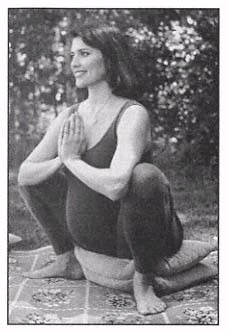
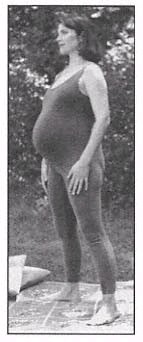
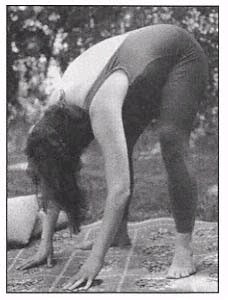
Page 62
Squat
: Assume the same beginning position as you took for the hip rocks and hip circles, then inhale, and, as you exhale, slide your hands down your legs, bending at the knees until you are all the way down into a squat. Push your legs apart slightly to accommodate your belly. Stay in this position for 45 to 60 seconds.
To come out of the squat, bring your hands to the floor in front of you, drop your head and slowly raise your buttocks to the ceiling. Then roll up slowly to a standing position. Stay there for a moment, regaining your balance, then do three cleansing breaths.
Modified Squat
: If you find that doing a full squat isn't comfortable for you, place pillows under your buttocks to give you extra support.
CAUTION
: Do not do a full squat if you have hemorrhoids as the pressure on your rectum can push the hemorrhoids out. Instead, do a modified squat against the wall with pillows under your buttocks. This will give you the opening, stretching benefits of the squat without putting undue pressure on your rectum.
BENEFITS: Squatting has many benefits both for your pregnancy and in terms of birth. Because of this, you should squat often, not just during this class. If at first you aren't able to go
Page 63
all the way down, practice (and keep practicing) until it becomes comfortable for you. Practicing in a large bath or a swimming pool is sometimes easier if you have access to these. You can also squat while you work in the garden; while you dress your toddler; while you hang out with a friend.
Squatting stretches and tones the muscles of the upper thighs and the perineum, making them strong and supple. It allows the muscles of the lower back to relax by relieving the pressure and weight of the growing baby on your lower spine and pelvic region. It is the best position to be in during the pushing stage of your birth as squatting actually shortens the birth canal, and being in the upright position allows for the natural pull of gravity to help you to birth your baby more easily. Squatting during labor eases back pain during the contractions, and it can help to stimulate contractions by allowing your baby's head to press more fully onto the cervix.
In a waterbirth, squatting is very comfortable. I gave birth to four of my children in the squatting position. The fifth baby had a shoulder briefly stuck. I gave birth to her on all fours, which allowed her shoulder to slide out easily.
Kegels:
Kegels are another exercise which can be done at any time and whose benefits cannot be stressed enough. Kegels, so named for the doctor who first developed them, are practiced by squeezing the muscles of the perineum and rectum very tightly, then holding for three to five seconds, and releasing. To make sure you are doing this exercise correctly, you can try it first while you pee. While peeing, tighten the muscles you would use to stop the flow of your urine. If you can stop the flow completely, your muscles are in good shape. If you can slow it down, but not stop it completely, your muscles are a little weak and need strengthening. If you aren't able to slow the flow at all, your muscles need a lot of work.
Begin by doing twenty to twentyfive kegels during this class, and then another twenty to twentyfive every time you pee. The recommendation is that you build up in this manner

Page 64
until you are doing two to three hundred kegels a day. That may seem like a lot, but if you consider doing twenty kegels every time you pee, which is about ten times a day for a pregnant woman, you will have done two hundred kegels. The other thing about kegels that makes doing so many of them realistic is that, as they are done completely internally, you can do them any time, anywhere, and no one will know you are doing them.
BENEFITS: Kegels strengthen all the muscles of the pelvic floor, keeping them strong and healthy during pregnancy and toning them up for the birth. Muscles that are in good shape stretch easier, tear less, and recover more quickly after the baby is born. Doing this exercise will also familiarize you with how your pelvic muscles feel when they are tight and how they feel when they are relaxed, and this will help you determine, while giving birth, if you are unconsciously tightening up. They also teach you to relax your pelvic floor on demand, a skill that will allow your cervix to open up more easily during your birth.
Moon Sequence:
This is a sequence of poses that moves one way, working one side of the body, and then moves back the other way, working the other side. They are to be done in succession, flowing one into the next, without breaking the movement. Begin by standing with your feet apart, facing forward.
Position one:
hands in prayer mode at the chest.
